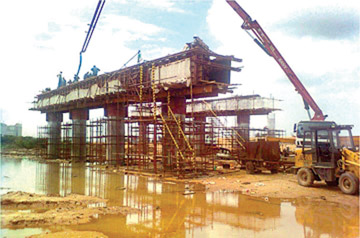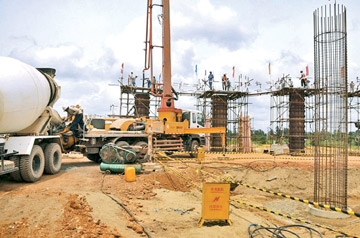|
Development
Best roads in region - the target :
Transport sector to undergo major transformation
The Southern Expressway extension to Matara
will be ready in 18 months, bringing Matara closer to Colombo and
opening new economic activities in the area
By Shirajiv SIRIMANE
 Sri Lanka’s transport sector is set to undergo a major transformation
and soon the country would be able to say with pride that it has the
best road network in the region. The way people travelled changed
drastically with the opening of the Southern Expressway last year, and
early next year the Colombo-Katunayake highway would be completed,
taking a passenger to the airport from Peliyagoda in less than 20
minutes. Sri Lanka’s transport sector is set to undergo a major transformation
and soon the country would be able to say with pride that it has the
best road network in the region. The way people travelled changed
drastically with the opening of the Southern Expressway last year, and
early next year the Colombo-Katunayake highway would be completed,
taking a passenger to the airport from Peliyagoda in less than 20
minutes.
Economic Development Minister Basil Rajapaksa said discussions are
under way with Qatar government officials for assistance to extend the
Colombo-Katunayake highway to Kalpitiya. The reason for the Qatar
government’s involvement in this project is their keenness to use three
islands in the Kalpitiya tourism zone to build hotels. “They want to
have quick access to these hotels and are keen on the highway
extension,” the Minister said.

Construction work under way |
 |
 |

Plans of highway projects |
 |
Today, the Colombo-Galle Expressway is viewed as one of the most
successful development projects in the country. It is ironic that the
very people who protested against it are today enjoying the benefits of
the project. Eight private and State-run Ashok Leyland buses are already
deployed from Maharagama to the Galle bus station and all of them are
running to capacity. The bus takes a passenger to Galle in one hour and
40 minutes and the fee charged is Rs. 470. The Southern Expressway
extension to Matara would be ready in 18 months, bringing Matara closer
to Colombo, and opening up new economic activities in the area.
Several star class hotel operators are already eyeing investment
opportunities as they have realised that many local and foreign guests
would arrive in the area along the highway. Today, thanks to the
highway, most hotels in Hikkaduwa are being upgraded and the area is
undergoing a major transformation. Sri Lanka would also see another
‘bit’ of history taking place in the highway mid-2012 with the opening
of two major restaurants near Bentota.
Restaurants
These restaurants would enable a driver to relax and refresh. Top
restaurant chains have already contracted with coordinator of the
project, Sri Lanka Insurance to open mini restaurants.
They will have parking facilities, toilets and other infrastructure
for the highway user and most importantly, be open to both sides of the
highway. They would be a major attraction for groups using the highway
and for families with children.
One of the other key developments that would take place with regard
to the Colombo-Galle Expressway this April would be the increasing of
the speed limit.
MP Namal Rajapaksa said that President Mahinda Rajapaksa, who himself
drove at 120Kmph at the opening, wanted to pass that benefit to the
public; this is expected to be a reality during the Sinhala and Tamil
New Year period. The Government has obtained financial assistance of Rs.
9,348.61 million (US$ 85 million) from the Asian Development Bank (ADB)
to rehabilitate the roads connecting to the Southern Expressway. The
total estimated cost for rehabilitation of these roads is Rs. 11,613
million (US$ 105.6 million). He also disclosed plans for the highway
being extended to Hambantota and then to Arugam Bay in the future.
The much awaited and long overdue Matara-Kataragama rail link along
Beliatta too would fall into track soon. The Government is to also
rehabilitate 662.04 km of national highways with concrete surfacing
through local contractors, using funds obtained by the Road Development
Authority amounting to around US$ 500 million from local banks.
Meanwhile, a World Bank study has commended the Government for
building the Colombo-Kandy Elevated Expressway and said it would
significantly reduce transport costs and connect under-developed regions
with developed ones.
Interchanges
The World Bank study said the planned expressway would yield more
gains in comparison to alternative road improvements that would only
reduce transport costs to a lesser extent.
The report further said the Expressway would greatly improve
connectivity between the two largest economic urban centres in Sri
Lanka, which would almost certainly be needed to meet the growing
shipping volume and traffic between these economic centres. The work on
the Colombo-Katunayake highway is now in progress with the entry and
toll points at the entrance to Katunayake almost complete.
Those entering the Katunayake highway from the Katunayake turnoff
roundabout would go through an overpass and travel along the lagoon.
They would once again cross the Negombo-Colombo road near Kerawalapitiya
where there is a major interchange where it would connect with the Outer
Circular Highway.
New Kelani Bridge Interchange (entrance and exit), Peliyagoda
Interchange and Ja-Ela Interchange would be the other entry points to
the highway. It would have 42 bridges and 88 culverts to ensure the
smooth flow of traffic.
The project initially commenced in 2003 but was halted due to lack of
funds. It was then funded with local capital; now Chinese credit has
been secured for the project. One of the biggest development projects in
the country, the highway would see an investment of over Rs. 37 billion
with 85 percent of the funding coming from China Exim Bank. It’s also
noteworthy that the Colombo-Katunayake highway was initially planned to
be completed before the Southern Expressway.
The Colombo outer circular express way would be a 29 km (18 mile)
long outer circular road network that will link the Colombo-Matara
Expressway with the Colombo-Katunayake Expressway. It will provide an
orbital beltway to bypass the city of Colombo and reduce traffic
congestion. The project is funded by the Japan International Cooperation
Agency (JICA).
The highway was planned to have six tracks from Colombo to Peliyagoda
and four lanes, from Peliyagoda to Katunayake.
The speed range will be 80 kilometres per hour from Colombo to
Peliyagoda and from Peliyagoda to Katunayake, 100 kilometres once
completed.
Special methods are being adopted to construct the road embankment in
marshy areas due to the prevailing weak soil conditions. Sea sand, which
has been already dredged, will be used in stabilising the weak soil.
The land acquisition and resettlement work is almost completed and
over Rs. 1.6 billion was spent as compensation for the acquired land.
Over 700 families have already been resettled.
The existing roads are being redone to have them in line with the
Expressway and this is evident in the Colombo-Kandy road up to Kadawatha
with an island being built in the middle of the road and the stretch
being carpeted.
Airport and Aviation Services Ltd., headed by Prasannna
Wickramasuriya, has already cleared the checkpoints, while SriLankan
Airlines has reduced the check-in time when entering the airport. Once
the highway is completed, taking a flight from Colombo would not be a
hassle at all.
|

